
BY DR. RAVINDER PALL SAINI
Ph.D ( FOREST ENTOMOLY), MBA
INIDIAN FOREST SERVICE ( RETIRED)
MEMBER ( BOARD OF MANAGEMENT),
FOREST RESEARCH UNIVERSITY, DEHRADUN.
DEHRADUN, 31 JANUARY 2023:
“The more I see of deer, the more I admire them as mountaineers. They make their way into the heart of the roughest solitudes with smooth reserve of strength, through dense belts of brush and forest encumbered with fallen trees and boulder piles, across canons, roaring streams, and snow-fields, ever showing forth beauty and courage.”
~~~~~~~~~ John Muir
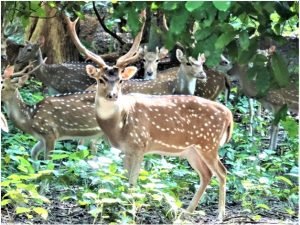
Common name: Chital (CHEE-tul)
Scientific name: Axis axis
Deer or true deer are hoofed ruminant mammals forming the family Cervidae.
Other names: Axis deer, cheetal, Indian spotted deer, Cerf axis, Axis-Hirsch, Ciervo
axis, Chitra, Jhank, Buryia, Chatidah, Darkar, Dupi, Jatat (also Jate, Játi), Kars, Lupi,
Mikka, Pali-man, Pullimal, Pasu, Pooli marn, Pústa, Sáraga, Saranga jinke, Tic huha, Tic muwa.
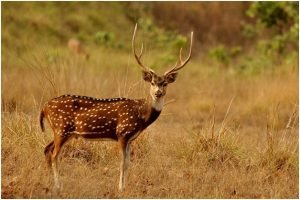
The species was first described by German naturalist Johann Christian Polycarp.
Erxleben in 1777.
Physical Characteristics:
Head and body length: 110-140 cm
Shoulder height: 75-100 cm
Tail length: 20-30 cm
Adult weight: 45-55 kg (females), 65-85 kg (males)
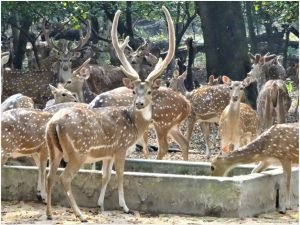
Chital are a lightly built species; males are larger and heavier than females. The bright reddish-brown coat of both sexes is marked with scattered white spots in all seasons. Near the belly the spots may merge to form a horizontal stripe. A dark line runs along the spine from shoulder to tail, and this is bordered by a row of spots. The underparts, including the underside of the tail, are white, and there is a white ‘bib’ on the upper throat. Males alone carry antlers, which have three tines: a brow tine and a terminal fork. Old males may retain a single set of antlers for over 19 months. The antlers typically grow 75-85 cm in length, with a record of 101 cm. When in hard rack (with fully developed antlers), males have prominent thick necks and a dark chevron above and between their eyes.
Reproduction and Development:
Gestation period: 225-235 days.
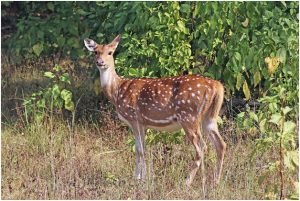
Litter size: 1, twins are very rare.
Weaning: Begins around three months; all young fully weaned by 6 months.
Sexual maturity: Females as early as 9-10 months, males at 14 months.
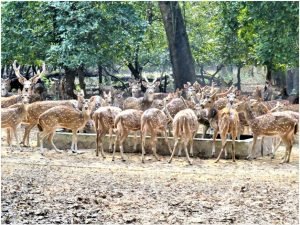
Life span: 15 years.
Chital have no fixed breeding season: males in hard antler may be found throughout the year, and infants may be born in any season. Fawns are born spotted, although they have shaggy coats which render their spots less conspicuous than in adulthood. For the first two weeks of life, fawns are cached in hiding spots and visited by their mothers for nursing. By four weeks of age, they are fully mobile and follow their mothers (and the rest of the herd) continually.
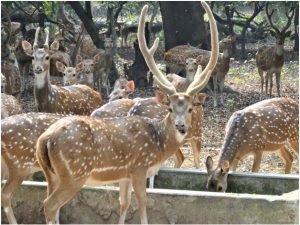
Ecology and Behaviour:
Chital are most active in the morning and late afternoon, and rest in shaded areas during the midday heat. Although grass forms most of the diet, in the dry season they will browse from trees and may even stand on their hind legs to reach leaves. Herds will feed under trees in which Hanuman langurs (Semnopithecus entellus) are feeding, taking advantage of food items dropped by the primates. They are very dependent on water and drink at least once per day. Population densities in dry forest are typically 20- 50 deer per km2 but can reach 200 deer per km2 in good habitat. Home ranges average 1.4 km2 for females and 1.95 km2 for males. Although this species is sociable (sometimes associating in groups of several hundred), the composition of herds is not stable and individuals within the group frequently change. Herds tend to travel in single file. Chital are wary creatures and are always alert for danger. When alarmed, they will stamp their forelegs and emit a shrill bark; they also pay attention to the alarm calls of other species such as Indian peafowl (Pavo cristatus). When fleeing from danger, the tail is raised to display the white underside.
Family group:
Typically, mixed herds of 10-30 animals throughout the year, although congregations of more than 200 have been recorded in the dry season.
Diet: Primarily short grasses, also herbs and foliage.
Main Predators:
Tiger, leopard, and dhole. Also, wolves, pythons, jackals.
Habitat and Distribution:
Chital inhabit open deciduous forests and grasslands throughout much of peninsular India and Sri Lanka. Proximity to a permanent water source is essential. The approximate range is depicted in the map below. Chital have also been introduced to Argentina, Australia, Brazil, South Africa, USA (Florida, Texas, California, and Hawaii), and Argentina.
(Pics by the author from field visits.)

Advertisement:





























Add Comment